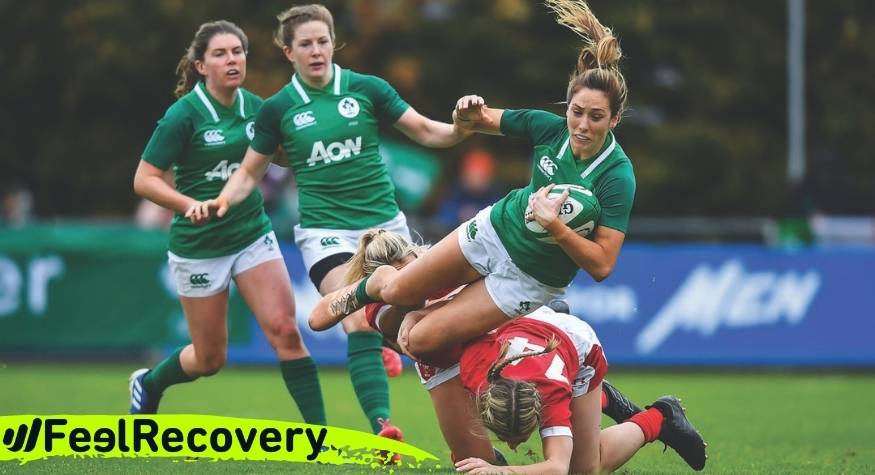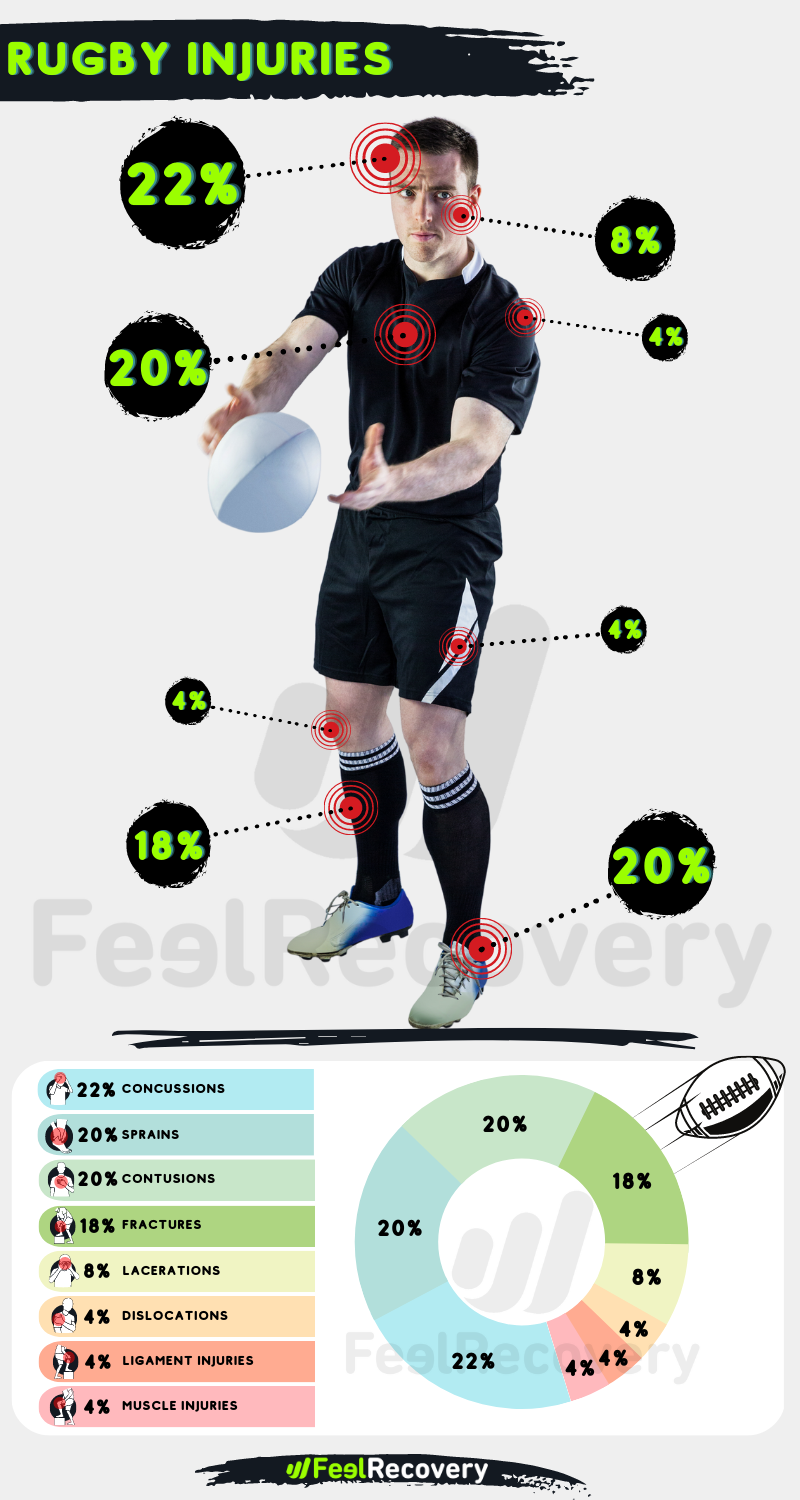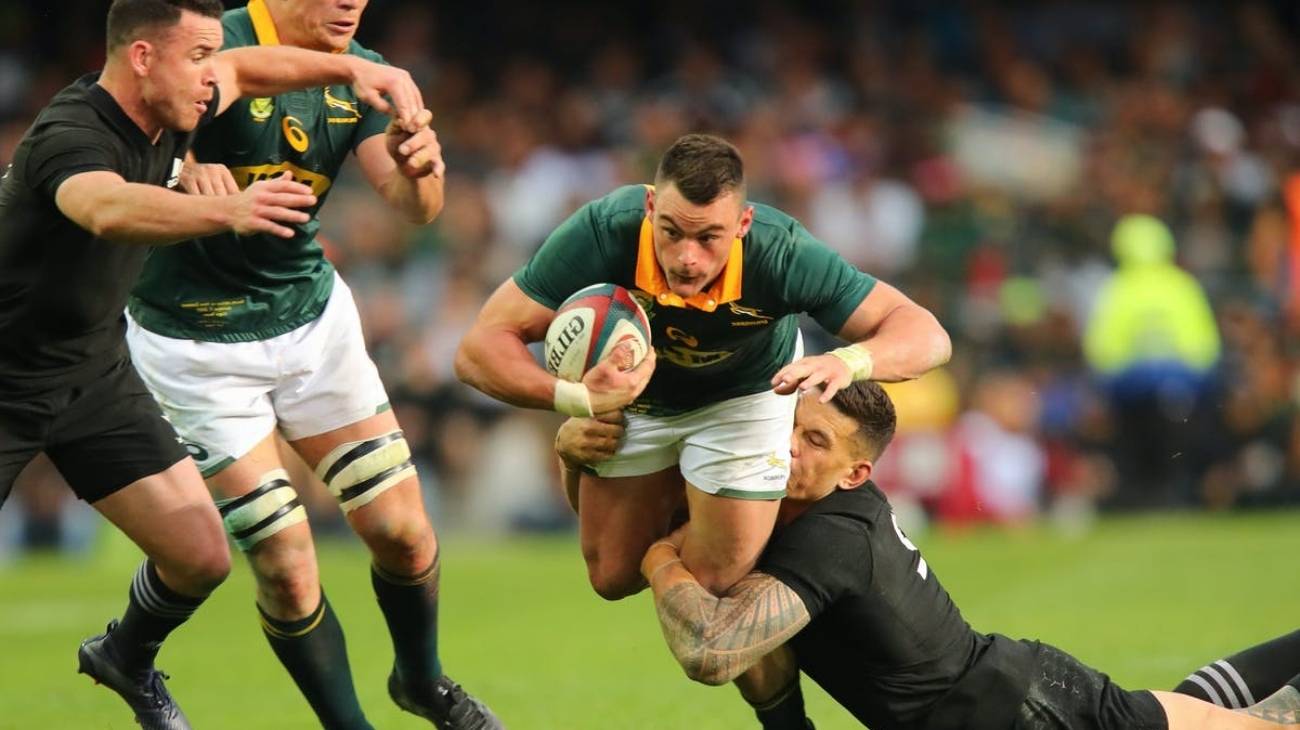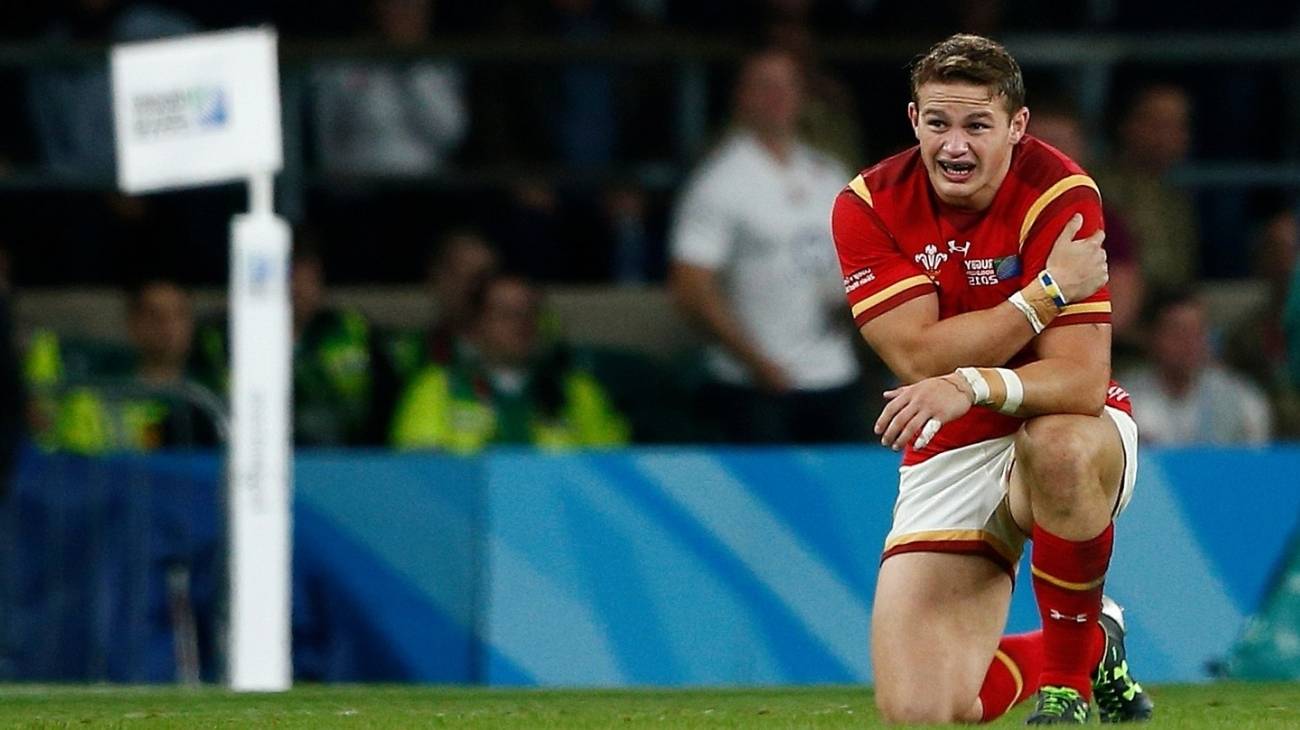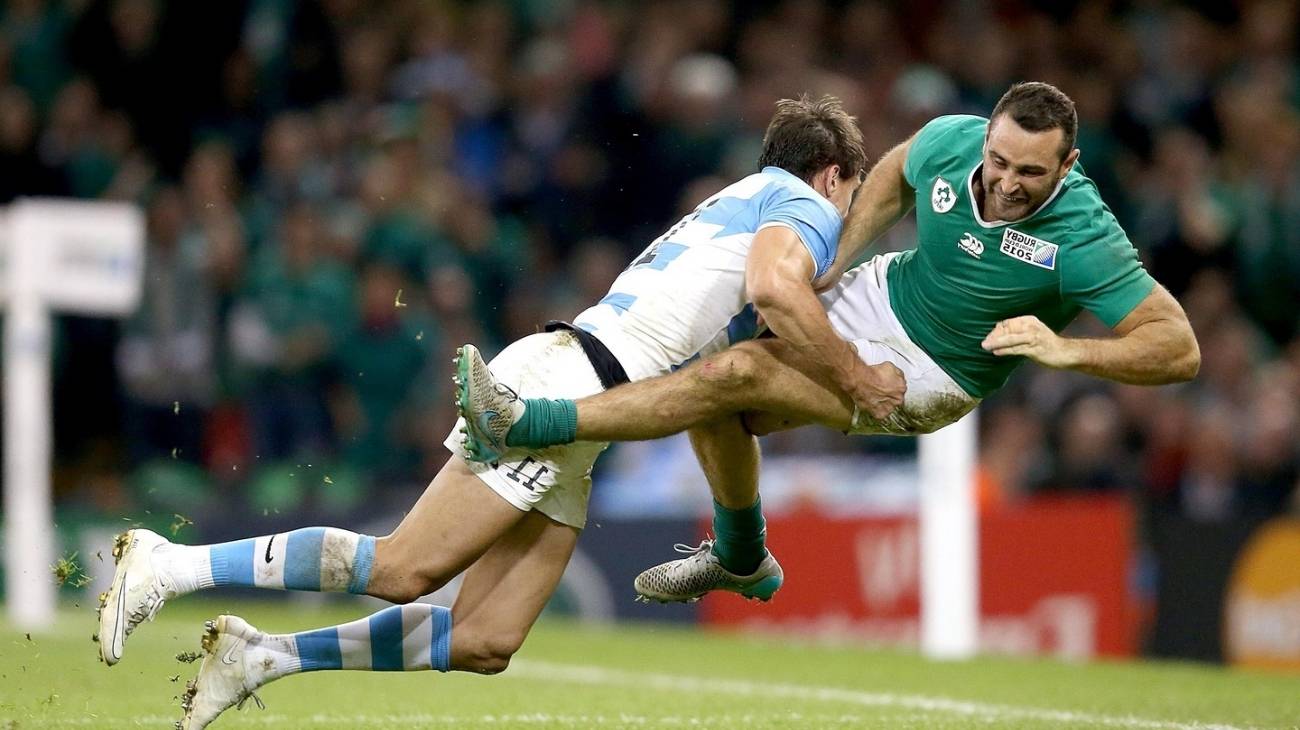Do you enjoy playing rugby and are you aware of the risks involved in playing this contact sport? Yes, amateur and professional rugby players are prone to injury when playing rugby. Fortunately, this time we will talk to you about methods of preventing sports injuries in rugby.
The strategies we will explain throughout this post will help you reduce the risk of injury during a rugby game or practice. Stay with us and you'll find out what they are and how to prevent common rugby sports injuries. Here we go!
What are the most common types of injuries when playing rugby?
The most common types of rugby injuries can be classified according to the area of the body in which they occur. The most commonly affected areas are the knee, shoulder and neck, however, they are not the only areas that are injured. Why do these injuries occur? Tackles, melees, running, sudden decelerations, falls, blows and so on during games or practices are the main risk factors.
The most common types of sports injuries in rugby are:
- Head injuries: These arise especially from trauma such as blows or impacts to the head. Concussions stand out, although other conditions such as facial fractures arise in this sport. Frontal tackles are very risky for this area, moreover, the possibility of dispensing with a helmet increases the danger.
- Neck injuries: Most are traumatic in aetiology and occur during play. Many are minor, but some can have tragic consequences such as quadriplegia or death. Cervical fractures and dislocations, strains, facet syndrome, brachial plexus injuries, herniated discs and bulging discs frequently occur in this area.
- Shoulder injuries: Shoulder injuries are caused by impacts, falls, and leverage that occur at the shoulder level in this sport. These injuries occur mainly during tackles. The most common conditions are shoulder dislocation, acromioclavicular joint sprain, rotator cuff tears, SLAP injuries and fracture.
- Hand and elbow injuries: Rugby players can suffer traumatic injuries to these areas such as finger dislocations. Overuse conditions such as tennis elbow tendonitis (lateral epicondylitis) are also common.
- Chest and lower back injuries: These areas are often subject to impact or other trauma during a rugby match and are therefore at risk of injury. Rib fractures and lumbar strains are prominent. The usual weight training of rugby players increases the risk of injury to the lower back.
- Knee injuries: Knee injuries include sprains as well as meniscal tears, which often occur as a result of trauma during a tackle. Also common are conditions such as patellar tendonitis, patellofemoral pain syndrome, patellar fracture and iliotibial band syndrome.
- Other lower extremity injuries: Ankle sprains are some of the most common lower extremity injuries. Strains of the hamstrings and other lower limb muscles are also common. Overuse conditions such as plantar fasciitis are also common.
Best products for rugby injury recovery
Bestseller
-
2 Calf Compression Sleeve (Black/Gray)
£17,50 -
2 Calf Compression Sleeve (Green/Navy)
£17,50 -
2 Calf Compression Sleeve (Pink/Bordeaux)
£17,50 -
2 Knee Compression Sleeve (Black/Gray)
£17,50 -
2 Knee Compression Sleeve (Green/Navy)
£17,50 -
2 Knee Compression Sleeve (Pink/Bordeaux)
£17,50 -
2 Thigh Compression Sleeve (Black/Gray)
£17,50 -
2 Thigh Compression Sleeve (Green/Navy)
£17,50 -
2 Thigh Compression Sleeve (Pink/Bordeaux)
£17,50 -
Acupressure Mat and Pillow (Black/Gray)
£44,95 -
Acupressure Mat and Pillow (Green/Navy)
£44,95 -
Acupressure Mat and Pillow (Pink/Bordeaux)
£44,95 -
Acupressure Pillow (Black/Gray)
£21,52 -
Acupressure Pillow (Green/Navy)
£21,52 -
Acupressure Pillow (Pink/Bordeaux)
£21,52 -
Back Support Belt (Black)
£29,95 -
Back Support Belt (Green)
£29,95 -
Back Support Belt (Pink)
£29,95 -
Foot Massage Roller for Plantar Fasciitis (Black)
£17,50 -
Foot Massage Roller for Plantar Fasciitis (Green)
£17,50 -
Foot Massage Roller for Plantar Fasciitis (Pink)
£17,50 -
Gel Eye Mask for Puffy Eyes (Gold/Black)
£9,95 -
Gel Eye Mask for Puffy Eyes (Orange/Pink)
£9,95 -
Gel Eye Mask for Puffy Eyes (Purple/Turquoise)
£9,95 -
High Density Foam Roller for Muscle (Black/Gray)
£24,95 -
High Density Foam Roller for Muscle (Green/Navy)
£24,95 -
High Density Foam Roller for Muscle (Pink/Bordeaux)
£24,95 -
Ice Massage Roller Ball (Black)
£34,95 -
Ice Massage Roller Ball (Green)
£34,95 -
Ice Massage Roller Ball (Pink)
£34,95 -
Microwave Wheat Bag for Back Pain Relief (Extra Large) (Hearts)
£25,50 -
Microwave Wheat Bag for Back Pain Relief (Extra Large) (Oxford)
£25,50 -
Microwave Wheat Bag for Back Pain Relief (Extra Large) (Sport)
£25,50 -
Microwave Wheat Bag for Neck & Shoulder Pain Relief (Hearts)
£21,50 -
Microwave Wheat Bag for Neck & Shoulder Pain Relief (Oxford)
£21,50 -
Microwave Wheat Bag for Neck & Shoulder Pain Relief (Sport)
£21,50 -
Microwave Wheat Bag for Neck Pain Relief (Hearts)
£17,50 -
Microwave Wheat Bag for Neck Pain Relief (Oxford)
£17,50 -
Microwave Wheat Bag for Neck Pain Relief (Sport)
£17,50 -
Pack 2 in 1: Foam Roller High + Soft Density (Black/Gray)
£24,95 -
Pack 2 in 1: Foam Roller High + Soft Density (Green/Navy)
£24,95 -
Pack 2 in 1: Foam Roller High + Soft Density (Pink/Bordeaux)
£24,95 -
Shoulder Support Brace (Black)
£21,95 -
Shoulder Support Brace (Green)
£21,95 -
Shoulder Support Brace (Pink)
£21,95 -
Soft Density Foam Roller for Recovery (Black)
£24,95 -
Soft Density Foam Roller for Recovery (Green)
£24,95 -
Soft Density Foam Roller for Recovery (Pink)
£24,95 -
Trigger Point Massage Stick (Black)
£12,95 -
Trigger Point Massage Stick (Green)
£12,95 -
Trigger Point Massage Stick (Pink)
£12,95
List of injury prevention methods for rugby players
Having delved into the common ailments in the sport, any rugby fan might be concerned. Fortunately, there are certain methods of injury prevention in rugby and we'll show you them below. Pay close attention and apply these strategies to reduce the risk of injury:
Warm up well
A good warm-up is necessary before any rugby game or training session. This allows the body to prepare for the sporting activity, which is vital to prevent injuries. Warming up correctly gradually increases heart rate, circulation, temperature and flexibility.
The warm-up can last between 10 and 20 minutes, starting at a low level of intensity and gradually increasing. Cardio exercises (such as jogging, jumping, etc.), joint movements, stretching, etc. should be included. Technical activities in pairs or groups can also be incorporated to help develop the skills needed to play rugby.
Finish training with a cool down
After finishing the sporting activity a cool down should be performed. This will allow the body (heart rate, temperature, breathing, muscle tone...) to gradually return to its resting state. As a result, muscle relaxation and recovery is promoted, as well as flexibility, which helps in the prevention of sports injuries in rugby.
Stretching should last approximately 15 minutes. Light aerobic activities such as walking and jogging should be included in this period. Stretching and deep breathing should also be included.
Good nutrition and hydration
Rugby players need to be well nourished and hydrated due to the demands of rugby, otherwise the risk of injury is increased. In general, these athletes need to consume adequately: wholegrain carbohydrates (cereals, bread, pasta...), proteins (lean meat, chicken, fish...), healthy fats (olive oil, avocado...), lots of vegetables and fruits. Of course, the amount of food to eat will depend on each person and it is vital to have a good nutritionist.
However, here are a few things to consider:
- Generally, you should eat a meal rich in carbohydrates and moderate in protein 3 or 4 hours before the match.
It is also recommended to eat a light meal with plenty of carbohydrates but low in fat and fibre 1 to 2 hours before the game. It should be easy to digest.
It is important to consume a carbohydrate, protein and electrolyte-loaded meal within 1 hour after the game or training.
It is advisable to drink fluids at meals and snacks. Sufficient water should also be consumed before, during and after the game or practice. Drinking sports drinks during the game is helpful.
Improve your fitness
Rugby players must be in excellent physical condition to meet the challenges of rugby. In general, rugby players need to develop a high level of strength, speed, endurance and agility. With such qualities they can be more efficient on the field and less likely to suffer injury.
In this respect, rugby players must undertake good training and physical conditioning in order to achieve these qualities. For this, it is of course important to consider the rugby player's position on the field of play.
Sports massage
Sports massage is widely recommended as a method of detection, treatment and prevention of sports injuries in rugby. They have two basic purposes: to prepare the rugby player for sporting activity and to aid recovery from exertion or injury.
These massages can be applied before, during and after a match or training depending on what is required. They have the potential to reduce pain and stiffness, increase range of motion and elasticity, inhibit inflammatory processes and promote tissue recovery.
Use of heat and cold therapies
This is also called contrast therapy and involves the application of alternating heat and cold. The most common way of using it is by alternating hot and cold baths within a certain period of time.
They generate a pumping effect on the circulation, using the vasodilatation and vasoconstriction processes generated by the high and low temperatures respectively. As a result, pain, inflammation and fatigue are reduced. Thus, this therapy is used in the treatment and prevention of sports injuries.
Use of compression garments
Compression garments are used by many rugby players. These athletes often wear them during games, training sessions and even when they are resting. They have ideal properties for the prevention of sports injuries in rugby.
According to some research, these garments promote muscle recovery after exercise. They also increase endurance by promoting circulation, oxygenation and waste drainage in the area where they are worn. They also dampen muscle vibrations and maintain an ideal temperature.
Use of acupressure therapies
Acupressure is a therapy originating from traditional Chinese medicine. It consists of applying pressure on certain points of the body using fingers, hands, objects, etc. It is similar to acupuncture. It is similar to acupuncture, except that no needles are used.
It is an alternative method for the treatment of diseases and various conditions. In fact, benefits such as pain relief and muscle relaxation are attributed to acupressure. Thus, acupressure is used by many in the treatment and prevention of sports injuries.
Use of thermotherapy and cryotherapy
Thermotherapy is the therapeutic application of heat and has great benefits. It promotes circulation, relieves pain, increases elasticity and is an excellent muscle relaxant. It can be used prior to sporting activity to warm up and increase flexibility, thus reducing the risk of injury. It is also used to treat injuries once the inflammatory phase has been overcome.
Cryotherapy, on the other hand, is the application of cold for therapeutic purposes. It has excellent analgesic, anti-inflammatory and antispasmodic effects. It is therefore one of the first methods applied in the treatment of injuries during the first 48 hours. It can be used after sporting activity to promote muscle recovery and relieve minor discomfort, thus preventing the occurrence of injury.
Use of good equipment
It is important that the shirts, shorts and other clothing used during matches and training sessions are comfortable, safe and compliant. Particular attention should be paid to shoes, as the use of inappropriate footwear increases the risk of injury.
In this contact sport, protective measures such as helmets, ankle, shin and mouth guards, among others, can be used. These are not compulsory, but the recommendation is to use them as a method of preventing sports injuries in rugby.
References
- Kaplan, K. M., Goodwillie, A., Strauss, E. J., & Rosen, J. E. (2008). Rugby injuries. Bulletin of the NYU hospital for joint diseases, 66(2), 86-93. https://www.safetylit.org/citations/index.php?fuseaction=citations.viewdetails&citationIds[]=citjournalarticle_88090_11
- Freitag, A., Kirkwood, G., Scharer, S., Ofori-Asenso, R., & Pollock, A. M. (2015). Systematic review of rugby injuries in children and adolescents under 21 years. British journal of sports medicine, 49(8), 511-519. https://bjsm.bmj.com/content/49/8/511.short
- Bottini, E., Poggi, E. J. T., Luzuriaga, F., & Secin, F. P. (2000). Incidence and nature of the most common rugby injuries sustained in Argentina (1991–1997). British Journal of Sports Medicine, 34(2), 94-97. https://bjsm.bmj.com/content/34/2/94.short
- Gibbs, N. (1994). Common rugby league injuries: recommendations for treatment and preventative measures. Sports Medicine, 18, 438-450. https://link.springer.com/article/10.2165/00007256-199418060-00007
- Carson, J. D., Roberts, M. A., & White, A. L. (1999). The epidemiology of women's rugby injuries. Clinical Journal of Sport Medicine, 9(2), 75-78. https://journals.lww.com/cjsportsmed/abstract/1999/04000/the_epidemiology_of_women_s_rugby_injuries.6.aspx
- Quarrie, K. L., & Hopkins, W. G. (2008). Tackle injuries in professional rugby union. The American journal of sports medicine, 36(9), 1705-1716. https://journals.sagepub.com/doi/abs/10.1177/0363546508316768
- Quarrie, K. L., Cantu, R. C., & Chalmers, D. J. (2002). Rugby union injuries to the cervical spine and spinal cord. Sports Medicine, 32, 633-653. https://link.springer.com/article/10.2165/00007256-200232100-00003
- Brooks, J. H., Fuller, C. W., Kemp, S. P., & Reddin, D. B. (2006). Incidence, risk, and prevention of hamstring muscle injuries in professional rugby union. The American journal of sports medicine, 34(8), 1297-1306. https://journals.sagepub.com/doi/abs/10.1177/0363546505286022
- Silver, J. R., & Stewart, D. (1994). The prevention of spinal injuries in rugby football. Spinal Cord, 32(7), 442-453. https://www.nature.com/articles/sc199471
- Newton, D., England, M., Doll, H., & Gardner, B. P. (2011). The case for early treatment of dislocations of the cervical spine with cord involvement sustained playing rugby. The Journal of Bone and Joint Surgery. British volume, 93(12), 1646-1652. https://boneandjoint.org.uk/article/10.1302/0301-620X.93B12.27048





















































































